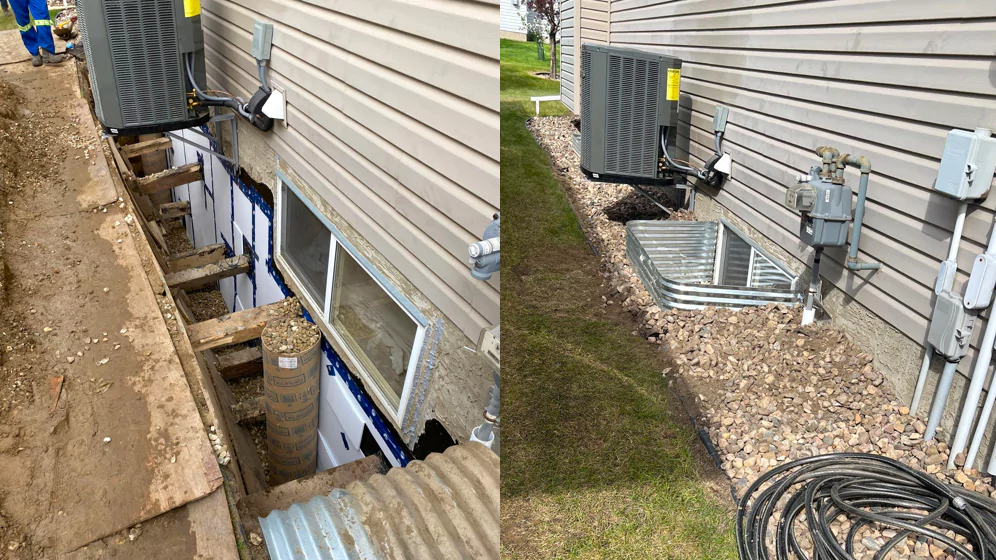If you have a basement, window wells are more important than you might think. They don’t just bring in natural light. They also protect your foundation from water damage, improve drainage, and ensure a safe emergency exit.
Without properly installed and maintained window wells, homeowners can face serious issues. Water pooling around basement windows can lead to leaks, mold growth, and even foundation deterioration. Poor drainage can cause flooding and potentially turn your basement into a costly mess.
In this article, you will learn:
- How window wells protect your foundation from water damage.
- The best materials and designs for durability and efficiency.
- Maintenance tips to keep your window wells working effectively.
Let’s dive in.
What Are Window Wells and Why Are They Important?
A window well is a small, dug-out space around a basement window that allows light and air into below-grade rooms while preventing water damage. Egress window wells are required by building codes for bedrooms. These provide an emergency exit in case of fire or flooding.
Without a properly installed window well, homeowners risk serious problems. Rainwater can pool near the window, seep through porous concrete, and enter your basement. Over time, this can lead to mold, structural damage, and even foundation issues. If the window well is filled with dirt or debris, the drainage system clogs, which causes water to back up near the bottom of the window sill.
Aside from water protection, window wells allow fresh air and natural light into the basement, which also improves ventilation and makes the space more comfortable. Egress window wells with ladders or steps ensure a safe evacuation route during an emergency.
However, not all window wells are available in the right design or material for every home. The right window well should be durable, properly sized, and professionally installed to prevent dirt from clogging drainage and ensure long-lasting performance.
A well-designed window well is required for both safety and home protection.
Next, we’ll explore the best materials and designs to consider.
Choosing the Right Window Wells – Materials & Designs
Not all window wells are created equal.
The right choice depends on durability, function, and design. Metal window wells (especially galvanized steel) and heavy-duty polycarbonate options tend to last the longest, while plastic and fiberglass alternatives may degrade over time.
Best Materials for Long-Lasting Performance
- Galvanized steel – Resistant to corrosion and impact, perfect for long-lasting performance.
- Concrete – Extremely strong but heavy and difficult to install.
- Polycarbonate or plastic – Lightweight, but can crack or warp under extreme weather conditions.
- Corrugated metal – Affordable and sturdy, but may require extra maintenance against rust.
Shield Foundation Repair does not cut corners. We install high-quality window wells built for durability, which ensures proper fit and function. Poorly installed window wells allow dirt and debris to clog drainage, which can cause water to enter your basement.
Why Proper Design Matters
The design of a window well is required to fit the basement window opening correctly. A semi-circular or rectangular shape should permit light while ensuring enough clearance for emergency egress.
A well-installed egress window well should have:
- Gravel at the bottom to help drain rainwater away from your foundation.
- A window well cover to prevent debris from entering the window well.
- Backfill graded so that water drains away rather than pooling near the foundation wall.
If you’re looking for metal window wells, galvanized steel, or other long-lasting options, choosing the right window well will depend on your home’s needs.
Next, we’ll look at professional installation and drainage solutions to ensure your window well is loose-free, well-fitted, and built to last.
Professional Installation & Drainage Systems
Proper window well installation is crucial for preventing basement flooding and long-term structural damage. A poorly installed egress window well can cause water buildup, clogged drains, and even foundation issues.
Step-by-Step Importance of Proper Installation
- A hole is dug at least 1 foot deeper and wider than the window opening to ensure proper fit and drainage.
- Gravel in your window well is added to help direct rainwater away from your foundation and prevent damp conditions.
- The metal or plastic window well is positioned securely against the foundation wall to prevent shifting.
- Backfill is graded to slope away from the house, which ensures proper drainage.
- A window well cover is added to prevent debris from entering the window well and clogging the system.
Why Expert Installation Matters
If a window well is loose, water can seep through the cracks, which often leads to flooding. It’s a good idea to have professionals install your egress window well to meet local building codes and ensure it functions as a proper emergency exit.
The Role of Drainage Systems
A proper drainage system includes gravel, a perforated pipe, and a connection to the home’s weeping tile.
If you’re unsure what exactly a weeping tile is and why it’s important, understanding its role in keeping basements dry can help you prevent costly damage.
Without these, basement window wells can fill with water, which could lead to moisture damage.
Shield Foundation Repair ensures every window well is installed correctly, which protects your home for the long term.
Maintaining Window Wells for Long-Term Protection
Even the best-installed window wells require maintenance. Falling into the window well of neglect, like letting debris build up, can lead to drainage failure and water damage in your basement.
How to Keep Window Wells Clear and Prevent Clogging
- Remove leaves, dirt, and debris regularly. If your window well is filled with dirt, water won’t drain properly.
- Check the window well cover for cracks or misalignment. A loose cover allows debris to enter the window well.
- Ensure the gravel in your window well hasn’t become compacted. If it’s improperly installed with sand, drainage can fail.
Signs of Damage or Poor Drainage
A window well is required to keep your basement dry, but over time, issues may arise.
Watch for:
- Damp walls or pooling water near the bottom of the window sill.
- A clogged drainage system, preventing water from escaping.
- Rusting or shifting of metal window wells due to improper backfill.
If you notice these issues, it’s crucial to be aware of the telltale signs that your window wells might be compromised. Ignoring them could lead to expensive basement repairs.
The Importance of Professional Inspections
If you notice any of these signs, it may be time for a professional assessment. Shield Foundation Repair can help you find solutions, which ensures your window wells continue to function properly. Without the use of expert techniques, even a minor issue can turn into a costly repair.
Taking care of your window wells protects your basement from flooding and keeps your egress window well safe for easy exit in an emergency.
Conclusion
A properly installed window well is essential for protecting your basement from water damage, ensuring proper drainage, and providing a safe egress exit when needed. Choosing the right materials, such as galvanized steel or durable polycarbonate, can make a significant difference in long-lasting performance. However, even the best window wells require professional installation and regular maintenance to prevent issues like clogged drains, leaks, and structural damage.
At Shield Foundation Repair, we specialize in high-quality window well installation and basement waterproofing solutions. Our team ensures that every egress window well meets local building codes, is graded correctly, and includes the necessary drainage systems, such as gravel and weeping tiles, to prevent water buildup.
Don’t wait for a flooded basement to take action. Contact Shield Foundation Repair today for a consultation and ensure your home is protected with professional window well solutions that stand the test of time.




